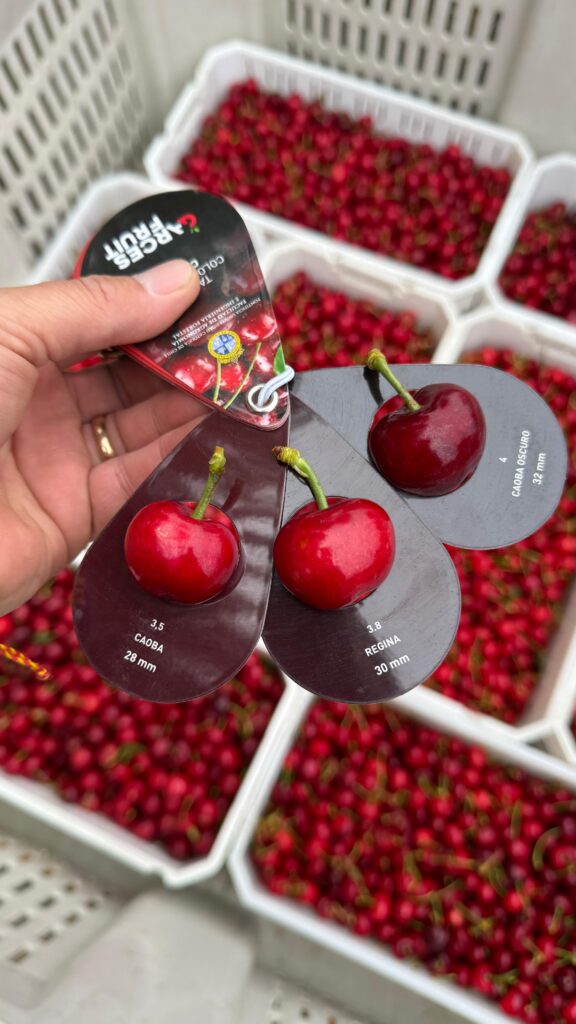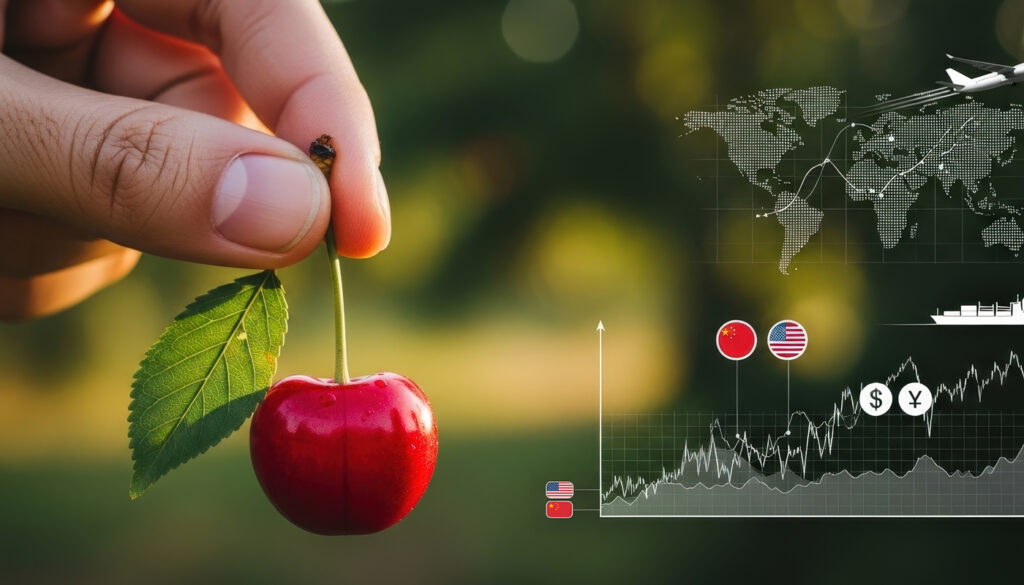By: Valeria Lepe, Agricultural Engineer, Mg. Sc. Specialist in fruit crop nutrition – Gonzalo Pezoa, Agricultural Engineer, Technical Chief, MAGNA Exporter, Miguel Vial Group – Carlos Tapia, Agricultural Engineer, M. Sc. Specialist in cherry production.
Balanced mineral nutrition plays a relevant role in the proper vegetative development of trees, both in the formation stage and in the fruit production cycle.
In trees in production, this adequate vegetative development must translate into fruit that is sufficiently balanced to allow it to have a post-harvest life in optimal conditions. Given that the quality of the fruit is produced in the orchard!, once in the packing house it is maintained or it could eventually suffer deterioration.
Under current production conditions, a comprehensive approach to the orchard is required, interpreting the largest number of productive variables to allow us to adjust nutritional programs for rational use and adjusted to each productive reality, considering the multiple factors that are at play in this species.
Focusing nutrition on a program concept is of utmost importance, because in this way we can demand better productive performance from the orchard each season, as long as we incorporate all the nutrients that are necessary based on the demand of the different components of the tree. Fruit nutrition has to be a tailor-made suit, because each orchard has its own particularities, “one size does not apply!”
Among the main considerations for the establishment of an adequate nutritional program are aspects such as: variety, rootstock, planting density, age of the trees, production history, yield estimation for the cycle in which fertilization is being planned, nutrient recycling, irrigation systems (fertigation), soil drainage limitations, irrigation needs/irrigation frequency (which could condition the partials that would be considered in the fertigation program), soil analysis, foliar analysis, fruit analysis and quantification of the vegetative expression of the orchard (vigor index).
In this same concept of relevant aspects for the establishment of the nutritional program, it is important to get used to building a history of nutritional analysis of the different plots, in terms of soil, leaves and fruit, which allow us to optimize nutritional decisions.
Bases to take into account in nutritional analysis
In the case of soil analyses, it is ideal to update the information every 3 years, and the validity should be a maximum of 5 years, given that current production systems are much more intensive and highly extractive; otherwise, we are looking at information that may no longer represent the current reality of the soil.
The ideal time to take soil samples should be at the end of winter: July-August, in orchards in full production, so that it is the starting point for the new spring fertilization cycle. The perfect procedure does not exist, but it is important to have a methodology that allows us to make comparisons across seasons and analyze the values in light of the management carried out during that period (hence the importance of setting a sampling time).
Some special situations may require monitoring of soil nutrient levels throughout the season, for example: July-August; December-January; March-April, in order to understand some processes that may be occurring at the soil level and that are related to the productive behavior that we are observing in the trees (for example, late mineralization, changes in pH, EC, etc.).

An important case can be revealed in the southern area of Chile, where pH is often the protagonist in terms of levels below sufficiency. This creates a very large gap between the CIC and the SB, due to the large participation of H+ and Al+.
Hence it is always important to compare the cations (Ca, Mg, K and Na) over the SB and not with the CEC for it to be an effective comparison.
Regarding the foliar analysisThe idea is to collect it around 110-125 ddpf, so that this information is useful in improving the summer post-harvest foliar program and in planning the next production cycle. The time of collection is related to the fact that the nutrients must be stable in the plant for it to be an effective reading.
In terms of dates, it should be sufficient to be able to take leaf samples after December 25.

For their part, the fruit analysis to harvest The objective is to measure the quality of the nutritional plan that has been implemented, both via soil and foliar, between pre-flower and harvest and thus optimize the management of the next productive season. The information generated allows to associate everything that was implemented at the orchard level with the potential of the fruit in storage, based on the balance that was achieved.

Vigor Index: The “gearbox” of the nutritional program
An indicator that has allowed us to continue optimizing the nutrient supply is the determination of the vigor index at the level of each block and based on the main varieties. This indicator has been very useful for segregating the behavior of vegetative growth in the different blocks and/or orchards and thus establishing a fertilization plan more tailored to the needs of each condition.
Keep in mind that the correct definition of ““vigor” is the vegetative development within the growing season, recognized in practice as the evolution of the annual outbreak. Do not confuse with the size of the trees, since large trees can be recognized, but they are not very vigorous because their annual development is deficient, and vice versa.
For the vigor index, a scale which fluctuates between 1 – 5; with a optimal value of 3.5. As this indicator begins to decrease and approaches values of 1, it means that we are in the presence of weakened trees, probably with serious problems in terms of development and recovery of their growth. At the other extreme, as the index begins to increase until reaching 5, it translates into very vigorous trees, with consequences in low fertility, inadequate distribution of nutrients in the different organs, low luminosity (excessive shade) and there is probably an association with phytosanitary problems such as some wood fungi and bacteria (Table 4).
The vigor index is related to the quality of fruit wood and the tree's ability to renew itself, given that as long as we have fruit wood with sufficient vigor, it means that we will have fruit with optimal size; otherwise, trees with weak fruiting material translate into fruit with poor caliber and that reaches harvest with serious difficulties to achieve adequate parameters; even recent evaluations indicate that it would also be associated with poor post-harvest behavior.

The idea is that the vigour index is assessed at various times during the season, for example: fruit set – shedding, veraison – pre-harvest, even during pruning, it can be rechecked for the following cycle; as it allows us to observe the vigour of the fruit wood and the quality of the renewal material.
Evaluations during the fruit growth cycle allow for reactions with certain modifications to the nutritional program, in situations where tree vigor is being affected by the high nutrient demand of the fruit (as occurred in some plots the previous season) or at the other extreme in the presence of low loads, the increase in tree vigor.
In the event that all corrections are not possible in the pre-harvest cycle, it will support the nutritional decisions of the summer post-harvest program that will be implemented immediately after the harvest and after the establishment of nutritional balance.
The idea of this indicator is to be the link between what is planned and the expression we see in the trees, allowing fine adjustment during the season, so as not to end the cycle with weakened or very vigorous orchards, without having had any signal.
In the search to be able to generate this information with greater precision and with less human performance, we have been working in recent seasons through the use of images (mainly through the use of drones), both orthophotos (RGB), spectral thermal images as well as the use of indicators such as NDVI (Normalized Difference Vegetation Index), for the interpretation of biomass (incorrectly called vigor) on a permanent basis and even to recognize the evolution during the season. These works are being carried out with good preliminary results in order to arrive at a more concrete management in the short term.
The work that is carried out permanently every season in the field together with the technical team of the orchards (teamwork), is to allow an adequate establishment of the Nitrogen requirement for the productive cycle. Given that the contribution of Nitrogen units per hectare is prepared based on the combination of vigor index, rootstock and yield estimate.
As an example, for a Lapins/Colt combination, with a vigor index of 3.5; with an effective extraction factor of 3.5 N units/ton of fruit produced and an estimated yield of 15 ton/ha, it means that it has a requirement of 53 N units/ha.
The way in which these units could be supplied is mainly via Calcium Nitrate, with the idea of starting the soil fertilization cycle around pre-flower/white bud in a partial way (starting to charge the system).
The above could be subject to some changes depending on the need for irrigation or the availability of water for irrigation in an early stage. This could adjust the number of partial irrigations that would be used in the fertilization program. In very heavy soils, fertilization irrigations ("technical irrigations") are not advisable and, in this case, the nutritional program must be compromised and adjusted to a smaller number of partial irrigations (the tree is an integration of all the productive factors, because otherwise, this contribution of nutrients will be absolutely inefficient). In the orchards of the southern zone, given the lower water demand in many cases, it is necessary to opt for a short fertilization irrigation, because otherwise it would not be possible to fertilize until almost December.
Another relevant element is the contribution of Potassium (K). In terms of requirements, consider extractions of around 7.5 - 12 K units/ton of fruit produced, which varies depending on the rootstock, varietal requirements, balance of the element in the sum of bases, significant changes in the estimation of yields as the growth cycle progresses, among other considerations.
Under this concept of a comprehensive program, the contribution of Calcium has become increasingly important, taking as a basis that it is a fundamental element for a sufficiently balanced fruit. From the perspective of contributions, the first of them could come from Calcium Nitrate (15.5% N + 18.9% Ca), which is implemented early in the season, even before flowering in areas where soil temperature and irrigation allow it; later, the use of floable Calcium is given way. There are countless options on the market, most with comparable concentrations in terms of Calcium contribution based on the weight/weight comparison. At similar concentrations of Ca w/w (for example, 25% Ca = 35% CaO), select the best options in terms of solubility and cost (US$/kg). Regarding the contribution of Ca units, via floable Calcium, the idea is to consider values around 25 Ca units/ha. However, formulations with a higher concentration of “carriers” such as carboxylic acids, plant extracts and even amino acids, can make a lower concentration of floable Ca more efficient in its use with good results.
With the idea of Calcium as a “luxury” consumption element, its incorporation is complemented by the foliar program, which begins in flower and continues until just before harvest, with the aim of ensuring that the fruit always develops with a good supply of Calcium (under the motto “more is more”). In addition, not losing sight of the fact that it is important to maintain a regular application frequency and in this way it is addressed in the planning of the application calendar at the orchard level (work of the orchard team in pursuit of compliance with what is planned).
It is very important to implement at the orchard level what was structured as a fertilization plan, trying to adjust the optimal incorporation times, if we want to achieve a positive response. It is worth highlighting the words of a producer:The secret is to actually implement what was planned and not just leave it on paper.”.
Currently, a nutritional program with a complete supply of nutrients via soil and foliar could represent between 25 – 30% of the cost of the phytosanitary program, hence the importance of a correct selection of the sources to be used. In the case of foliar lines, it is very important to select those that allow us to make mixtures with absolute safety.
Under the concept of a fertilization program, we must not lose sight of the fact that everything we have previously mentioned is also accompanied by most of the foliar elements, such as: Potassium, Magnesium, Phosphorus, Boron, Zinc, Amino Acids, Biostimulants, Multiminerals and Bioelicitors, depending on the requirements of each orchard condition.
The implementation of the most appropriate management for each orchard requires a great deal of teamwork, both by the internal staff and by the professionals who provide technical support to the fruit projects, since today more than ever a comprehensive view of the tree is required to meet production requirements.










